Yogurt consumption is linked to healthier lifestyle
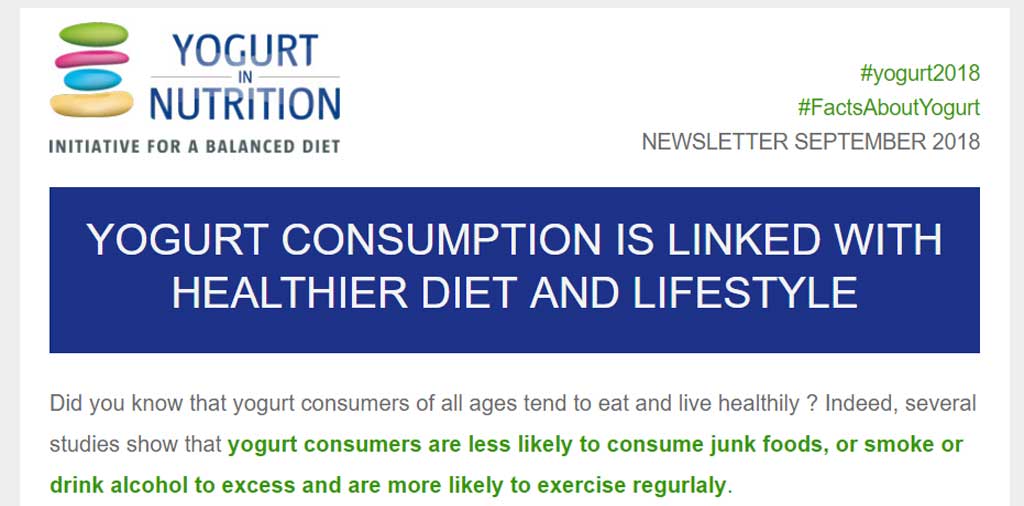

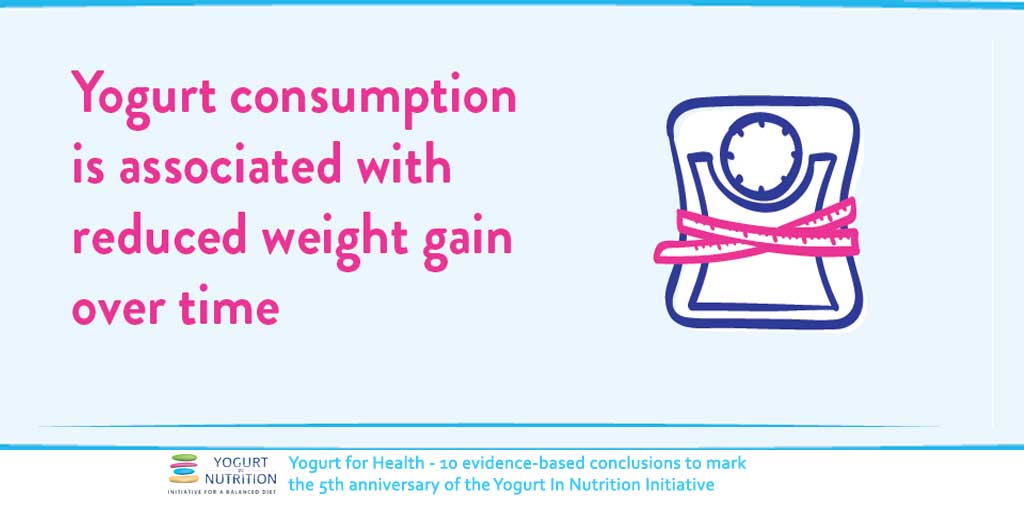
“Yogurt consumption is associated with reduced weight gain over time” is one is one of the 10 evidence-based conclusions made by the YINI board about the health effects of yogurt… learn more below.
The effect of yogurt on satiety may partly explain findings by recent reviews that yogurt consumption is associated with lower body mass index (BMI), lower body weight or weight gain, smaller waist circumference and lower body fat.
Studies in adults
Yogurt consumption appears to protect against longterm weight gain, according to pooled results from cohort studies.
This effect is doubled with plain or artificially sweetened yogurt compared with flavoured sweetened yogurt. These results support those of an earlier analysis in which eating more yogurt was associated with less weight gain per 4-year period among 120,877 US healthy non-obese adults followed up for 12–20 years. For each additional serving of yogurt per day there was
372 g less weight gain (Figure 1).
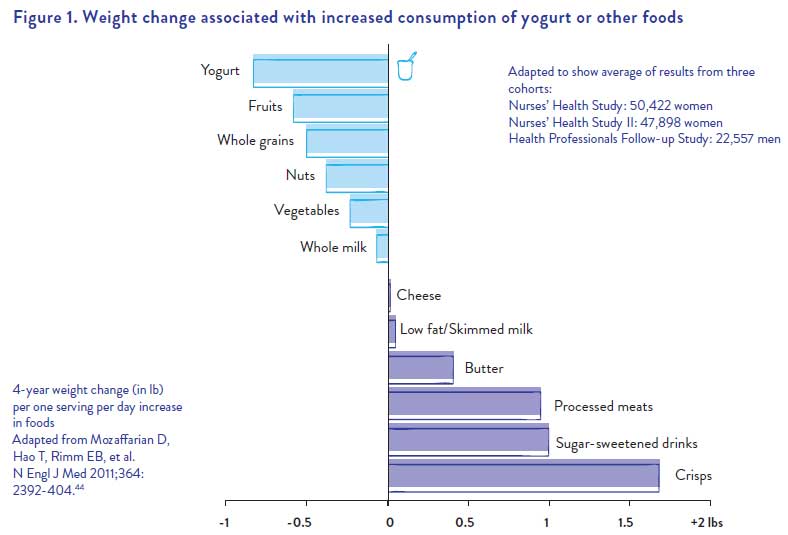
Studies in Children
Results from the NHANES in US children aged 8–18 years (NHANES 2005–2008) and the Healthy Lifestyle in Europe by Nutrition in Adolescence (HELENA) study showed that yogurt consumption was associated with less body fat.
References:

Bone loss after the menopause poses a problem for many women because weakened bones become prone to breaking later in life. Although you can’t stop age-related bone loss completely, there are steps you can tale to reduce it. A good way to start is staying active and eating a healthy, balanced diet. As part of this bone-friendly diet, dairy products provide a package of nutrients that may help to give our bones the boost they need. But it seems that fermented dairy products such as yogurt may hold advantages over milk and other dairy products, this latest study suggests.
Dairy products are rich in calcium, protein, potassium, phosphorus and vitamin D – all important nutrients for maintaining bone strength. Fermented dairy products such as yogurt, fresh cheese, quark and kefir not only provide these key nutrients but also contain two possible ‘magic weapons’ against bone loss: probiotics and prebiotics
Probiotics are live microorganisms that, when administered in adequate amounts, confer a health benefit on the host. Prebiotics are selectively fermented ingredients that allow specific changes in the composition and/or activity of the gut microflora that confer benefits to the host.
The authors of this study set out to discover whether eating fermented dairy products such as yogurt could have a stronger influence on measures of bones loss than other dairy products.
They examined the diets of 482 Swiss women who were 65 years old and assessed their bone health and levels of body fat. Bone scans and blood tests were used to measure bone loss. The authors then repeated the same assessments three years later to see if there were any differences.
At the first assessment, women who ate fermented dairy products had larger bones in their forearm and lower leg (radius and tibia) than women who didn’t eat these foods. There weren’t any differences in bone loss measures at this point.
However, by the three-year assessment, women eating fermented dairy products had less bone loss in the radius of the forearm than women not eating these foods. Milk consumption was associated with some benefit, but eating ripened cheese had no effect on bone loss.
‘…the benefit of FDP [fermented dairy products] was not observed with other dairy products (milk and ripened cheese) and was partially independent of total energy, calcium, and protein intakes.’ – Biver et al, 2018.
Women who ate fermented dairy products had lower body fat and were less likely to be obese than women who didn’t eat these foods. Milk or ripened cheese consumption didn’t show this relationship with body fat.
The association between fermented dairy intake and lower body fat is good news for our health. Body fat, and particularly excess fat around the waist, is known to be a risk factor for type 2 diabetes, heart disease and stroke. Indeed, previous research has suggested that dairy products, particularly yogurt, have a possible role in preventing type 2 diabetes.
‘It is well established that abdominal adipose tissue [fat] is associated with the development of cardiovascular disease, insulin resistance, type 2 diabetes mellitus, and even all-cause mortality.’ – Biver et al, 2018.
The prebiotics and probiotics contained in yogurt and other fermented dairy products may be important for regulating our gut microbiota –which in turn may influence calcium absorption by increasing the permeability of the intestine. The gut microbiota may also affect chemicals leading to a decrease in bone resorption.
Another possible explanation is that consuming fermented dairy products is simply a signature of a healthy diet and lifestyle that may benefit bone health. However, in this study the link between fermented dairy product consumption and changes in bone characteristics remained regardless of the participants’ smoking, alcohol consumption, and physical activity.
The authors recommend that studies should be conducted in other populations to confirm the potential benefits of fermented dairy products on bone health. Working out how fermented dairy products might exert their effects on bone health would also add support to the findings of this study.
Find out more: read the original article.

You might be looking forward to a long and well-deserved retirement, but where’s the fun if you become frail and unable to enjoy doing the things you love? Maybe the answer lies partly in what you eat. This latest study strengthens the large body of evidence suggesting that consuming dairy products every day helps to improve bone health in the elderly.
Although some loss of bone is normal as we get older, some people lose bone density at an abnormally fast rate because of osteoporosis, and so have an increased risk of broken bones. But there are steps we can take to strengthen our bones and reduce the risk of fractures in later life.
Dairy products contain lots of calcium so you’d expect that eating more of these foods would be good for your bones. However, this has been difficult to prove. In fact, a Swedish study suggested that increasing milk intake may lead to higher death rates and fracture rates in older adults. The same study found that eating fermented dairy products such as soured milk and yogurt was associated with lower death and fracture rates. So, how do we know what to believe?
The authors of this article carried out a separate study in physically active, 70-year-old Swedish men and women to look at the effect of dairy products on bones, and to see whether there were indeed differences between dairy types.
Bone scans were done to measure bone mineral density and also to look at the internal structure of long bones in the forearm and lower leg (radius and tibia). These assessments of bone strength were then compared across groups of people consuming different types of dairy products or none at all.
Although the effects weren’t very large, half a glass of milk or a pot of yogurt daily were associated with better bone strength. This association wasn’t affected much by the amount of cheese being eaten. The authors didn’t look at fracture rates so it’s not possible to say whether the better bone strength relates to a reduction in fractures.
Whereas the previous Swedish study reported differences in fracture rates for milk and fermented dairy products, this study did not show a difference in bone strength measurements between these foods.
‘….we found a weak positive association between dairy product consumption and some of the bone sites, regardless of the type of dairy product consumed.’ – Hallkvist et al, 2018.
The authors didn’t discover any negative effects of dairy products on bone health in this elderly population. This is consistent with many previous studies, providing reassuring evidence for eating more dairy products to improve our long-term bone health.
The authors conclude that further studies are needed to see if there are similar associations between intake of dairy foods and bone health in other age groups.
Find out more: read the original article.
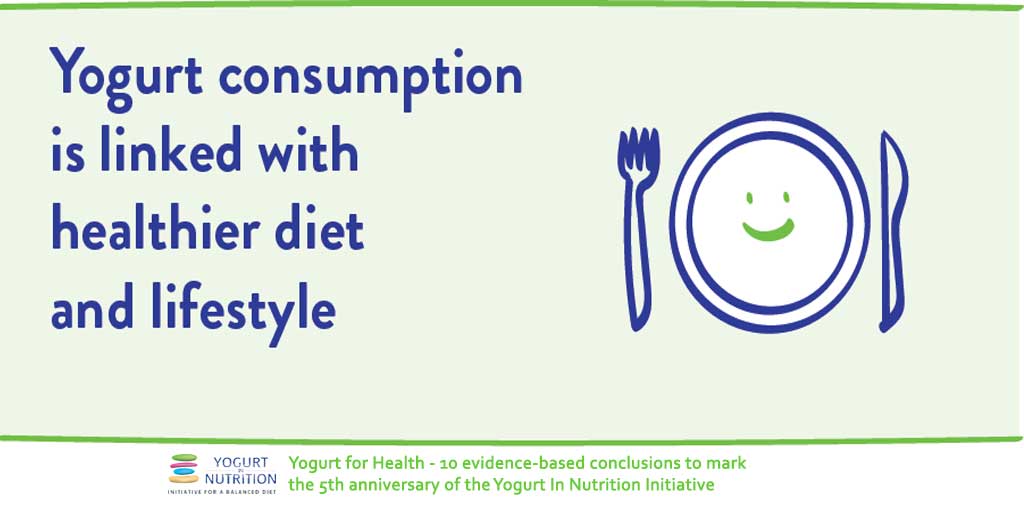
Yogurt consumption is linked with healthier diet ” is one is one of the 10 evidence-based conclusions made by the YINI board about the health effects of yogurt… learn more below
Yogurt consumption is a marker of a healthier diet and lifestyle
Numerous studies suggest yogurt consumption is a signature of a healthy diet and lifestyle.
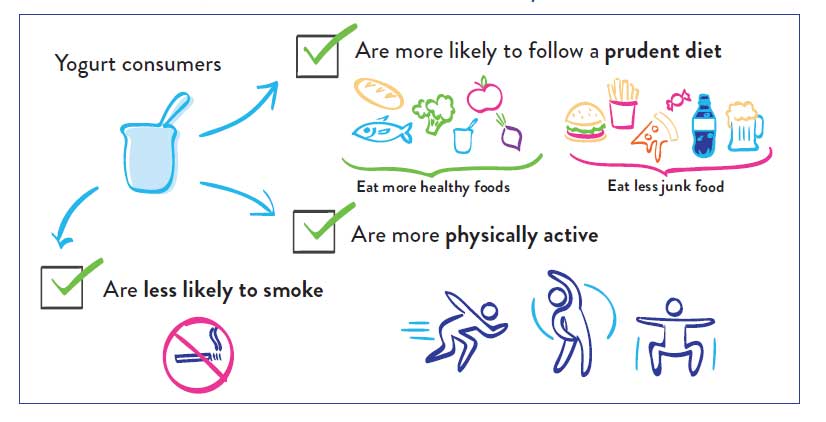
Compared with people who do not eat yogurt, those who do consume yogurt:
Yogurt consumption is linked with a lower risk of a variety of chronic diseases.
“Yogurt consumers are characterised by healthier dietary habits than non-consumers and are also known to display healthier non-nutritional behaviours. This has led to the proposal that yogurt consumption may represent the signature of a healthy diet and lifestyle.” – Dr Angelo Tremblay

YINI experts will gather during the coming IV World Congress of Public Health and Nutrition, held jointly with the XII Congress of the Spanish Society for Community Nutrition (SENC), to be held on 24-27 October 2018 in Madrid (Spain).
The central theme of this new YINI symposium, organized on the 25 October, from 5:00 to 6:30 pm, is “Yogurt as a vehicle of healthy eating in children” with the following program.
YOGURT AS A VEHICLE OF HEALTHY EATING IN CHILDREN
Chairs:
Luis Moreno (University of Zaragoza. Zaragoza. Spain) and Gregorio Varela-Moreiras (CEU San Pablo University. Madrid. Spain)

Does a scorching hot summer sap your energy and leave you feeling tired and drained? Maybe you suffer from summer heat fatigue, a package of bothersome symptoms such as fatigue, loss of appetite, loss of sleep, stress, and lack of motivation. Some people even tend to catch a cold every summer. The problem is set to spiral as global warming takes hold and long hot summers become the norm.
But if for you summer spells trouble, you may find that eating a daily yogurt helps to alleviate the tiresome symptoms, according to this study from Japan.
Summer heat fatigue is thought to be common and may be related to a disruption in the immune system, say the authors.
Yogurt contains live bacteria and previous research has shown that the immune system may be stimulated by consuming yogurt fermented with the lactic acid bacterium, Lactobacillus delbrueckii subsp. bulgaricus OLL1073R-1. In the elderly, yogurt made with this bacterial strain reduces the risk of catching colds and improves quality of life in areas of motivation, irritation, stress, and fatigue.
This yogurt might therefore be a promising candidate for combating summer heat fatigue, the authors reasoned.
They recruited 49 healthy men aged 30–49 years who felt fatigued every summer. The men were randomly assigned to receive a 100mL bottle of either yogurt or a placebo (milk with added lactic acid) every day for 12 weeks leading up to early autumn. They were asked to score their symptoms on a visual scale.
After 12 weeks the scores for general malaise, fatigue, feeling languid and stress were all lower in the yogurt group compared with those having placebo. The scores also showed the participants in the yogurt group felt less languid, tired, and stressed at the end of the study than they did before starting their daily yogurt routine.
The study also showed that he autonomic nervous system which is responsible for many functions in the body appeared improved in the yogurt group, from six weeks after starting the trial until the end of the trail.
‘Yogurt may tune the balance of the autonomic nervous system and relieve the physical and mental disorders induced by seasonal changes.’ – Makino S et al, 2018.
Yogurt may achieve these benefits in summer heat fatigue through a variety of ways. This strain of lactic acid bacterium produces high levels of a carbohydrate, exopolysaccharide, and the authors suggest this may have numerous impacts including an effect on the immune system and antioxidant activity. However, in this study they measured levels of an immune marker and found no marked difference between the group receiving yogurt and the placebo group.
Further studies are therefore needed to confirm these findings and to determine whether summer heat fatigue is indeed connected with a disruption of the immune system, the authors conclude.
‘These findings provide new insights into the health-promoting effects of yogurt fermented with L. bulgaricus OLL1073R-1.’ – Makino S et al, 2018.
Find out more: read the original article.

Yogurt consumption is linked with healthier diet ” is one is one of the 10 evidence-based conclusions made by the YINI board about the health effects of yogurt… learn more below
Regular yogurt consumers tend to choose healthier diets

Regular yogurt consumers are less likely to consume junk food and more likely to stick to dietary guidelines.
Children
Adults

“Yogurt consumption is linked with healthier diet ” is one is one of the 10 evidence-based conclusions made by the YINI board about the health effects of yogurt… learn more below
Regular yogurt consumers of all ages tend to eat and live healthily. They are less likely to consume junk foods, or smoke or drink alcohol to excess, and are more likely to exercise regularly.
Yogurt consumers are more likely to have adequate intakes of key nutrients
> Learn more about the study: Yogurt consumtion associated with a better diet quality and metabolic profile
> Yogurt and fruits: the winning combination
> Find here through this infographic why yogurt is a great snack for children
> Discover more about how yogurt does fit in nutritionally adequate diet.

Acne is the bane of adolescence, affecting as many as 50-95% of teenagers. It can bring misery to young people’s lives just when they’re feeling most concerned about how they look. And it’s not just youngsters who can suffer from it – although most common during puberty, acne can affect anyone of any age or sex.
Acne arises when the sebaceous glands secrete too much sebum, and the opening of the follicles in the skin become blocked. Often the Western diet – especially cow’s milk and dairy products – is thought to play a role in the development of acne.
Previous studies investigating this potential role have given conflicting results. To get a clearer picture, the authors of this article reviewed 14 studies and analysed the results to see whether the risk of acne is indeed linked to the dairy products we eat.
Their results show that the risk of acne varies according to the type of dairy product consumed. Hence, drinking milk was associated with the presence of acne. The more whole milk or skimmed milk people drank, the higher their risk of acne, each additional serving of whole milk and skimmed milk increasing the risk of acne by 13% and 26% respectively.
But no such relationship was seen between risk of acne and yogurt or cheese intake. The authors’ review included four studies of yogurt/cheese intake, and none found a significant link with acne, regardless of the amount of yogurt or cheese eaten.
‘In this meta-analysis, the consumption of yogurt/cheese had no relationship with the risk of acne’ – Aghasi M et al, 2018.
The proteins found in milk and dairy products increase the levels of a hormone, insulin-like growth factor-1 (IGF-1), which in turn stimulates the sebaceous glands to make more sebum – and so the development of acne.
Milk and dairy products also contain sex hormone derivatives such as oestrogen, progesterone and androgen, that can lead to the development of acne.
The lack of a relationship between yogurt/cheese and acne may be due to the fermentation process, say the authors. Fermentation with probiotic bacteria may reduce IGF-1 levels of the dairy food as well as other components of milk that are associated with acne development.
Further studies – especially large-scale clinical trials – are needed to confirm the effect of milk and dairy products on the development of acne, say the authors. In the meantime, they recommend that people who want to avoid acne should consider opting for yogurt or cheese as their source of dairy food.
‘Results of the present meta-analysis recommend the consumption of yogurt/cheese to avoid acne creation.’ – Aghasi M et al, 2018.
Find out more: read the original article.

